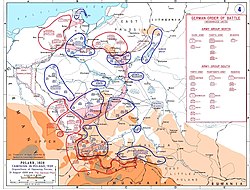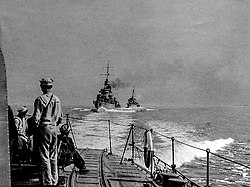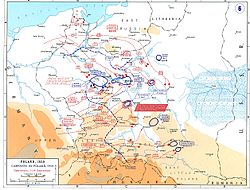Invasion of Poland (1939)
The Invasion of Poland in 1939 was a military offensive in which Nazi Germany and, two weeks later, the Soviet Union invaded Poland. That was the start of World War II in Europe.
| Invasion of Poland | |||||||||
|---|---|---|---|---|---|---|---|---|---|
| Part of World War II | |||||||||
 The map shows the beginning of the Second World War in September 1939 in a wider European context. | |||||||||
| |||||||||
| Belligerents | |||||||||
|
| File:Flag of Poland (1928–1980).svg Poland | ||||||||
| Commanders and leaders | |||||||||
|
(Ukrainian Front) | File:Flag of Poland (1928–1980).svg Edward Rydz-Śmigły | ||||||||
| Strength | |||||||||
|
Germany: Total: 1,500,000 Germans,[1] 466,516 Soviets,[3] 51,306 Slovaks Grand total: 2,000,000+ |
Poland: 39 divisions (some of them were never fully mobilized and concentrated),[4] 16 brigades,[4] 4,300 guns,[4] 880 tanks, 400 aircraft[1] Total: 950,000[Note 1] | ||||||||
| Casualties and losses | |||||||||
|
Germany:[Note 2] USSR:[Note 3] 1,475 killed or missing, 2,383 wounded |
Poland:[Note 4] 66,000 dead, 133,700 wounded, 694,000 captured | ||||||||
The invasion started on 1 September 1939. The invasion of Poland caused the United Kingdom and France to declare war on Germany on 3 September, but they did little to affect the September Campaign. The fighting ended on 6 October. Germany and the Soviet Union had conquered Poland and divided it according to their Molotov-Ribbentrop pact.
It is often called the first time that blitzkrieg was tried on the battlefield, but similar methods had been used earlier. The German surprise attack was successful and was very effective against the ineffective and demobilized Polish Army, whose tanks and airplanes were few and mostly old. The Poles were outflanked, outmaneuvered, and outnumbered in September 1939 and easily destroyed by the Germans. The Poles, if they had been well prepared, could have had two million soldiers fighting.
In the first few days of the German invasion, Poland proved to be more difficult to invade than the Germans had expected. In the Battle of Mokra, on September 2, the Poles repulsed an attack by a German Panzer division and forced its retreat.[13] The Luftwaffe, unlike during the Germans' invasions of other countries, did not easily overcome the outnumbered Polish Air Force. However, the Germans' great superiority in numbers made them gain air superiority after five to six days.
Surrounded by German territories north, west, and south of Poland, the Poles had little space for tactical retreat. The Germans reached Warsaw and attacked on September 7 but were repulsed. They had suffered heavy tank losses and so were forced to retreat.
The Battle of Bzura, on September 9, was the largest attack by the Poles during the war. The Poles had great initial success by decimating two German divisions and taking 3500 German prisoners. The Polish infantry fought well, but by September 19, the overwhelming German reinforcements had defeated the Poles.
The Poles realized the British and French were in the Phoney War and had no intention of assisting Poland, and the Soviet Red Army invaded Poland from the east on September 17. The Polish High Command ordered the troops and equipment to the Romanian Bridgehead to enter Romania with the intention to continue their resistance by moving as much of their army to France as possible. Most of the Polish Navy escaped to Britain. Polish cryptographers who had cracked the German Enigma machine went to France and later to Britain to continue their work.
Polish politicians set up a government-in-exile in France and later escaped to Britain. In 1945, when the Allied armies invaded Germany and forced its surrender, the Polish Army was the fourth-largest Allied army.
Invasion Of Poland (1939) Media
Vyacheslav Molotov signs the Molotov–Ribbentrop Pact, a German–Soviet non-aggression pact.
Polish infantry marching 1939.
Polish PZL.37 Łoś bomber aircraft in 1939
Polish 7TP light tanks in formation during maneuvers
Peking Plan: Polish destroyers evacuate the Baltic Sea en route to the United Kingdom.
Hitler watching German soldiers march into Poland in September 1939.
Notes
- ↑ Various sources contradict each other so the figures quoted above should only be taken as a rough indication of the strength estimate. The most common range differences and their brackets are: German personnel 1,500,000 (official figure of the Polish Ministry of Foreign Affairs) – or 1,800,000. Polish tanks: 100–880, 100 is the number of modern tanks, while the 880 number includes older tanks from the WWI era and tankettes.[5][6]
- ↑ The discrepancy in German casualties can be attributed to the fact that some German statistics still listed soldiers as missing decades after the war. Today the most common and accepted numbers are: 8,082 to 16,343 KIA, 320 to 5,029 MIA, 27,280 to 34,136 WIA.[7] For comparison, in his 1939 speech following the Polish Campaign Adolf Hitler presented these German figures: 10,576 KIA, 30,222 WIA, and 3,400 MIA.[8] According to early Allied estimates, including those of the Polish government-in-exile, the number of German KIA casualties was 90,000 and WIA casualties was 200,000[8][9] Equipment losses are given as 832 German tanks [10] of with approximately 236[10] to 341 as irrecoverable losses and approximately 319 other armoured vehicles as irrecoverable losses (including 165 Panzer Spahwagen – of them 101 as irrecoverable losses)[10] 522–561 German planes (including 246–285 destroyed and 276 damaged), 1 German minelayer (M-85) and 1 German torpedo ship ("Tiger")
- ↑ Soviet official losses are estimated at 737 to 1,475 KIA or MIA (Ukrainian Front – 972, Belorussian Front – 503, and 1,859 to 2,383 WIA (Ukrainian Front – 1,741, Belorussian Front – 642). The Soviets lost approximately 150 tanks in combat of which 43 as irrecoverable losses, while hundreds more suffered technical failures.[3]
- ↑ Various sources contradict each other so the figures quoted above should only be taken as a rough indication of losses. The most common range brackets for casualties are: Poland: 66,000 to 70,000 KIA, 134,000 WIA.[7] The often cited figure of 420,000 Polish prisoners of war represents only those captured by the Germans, as Soviets captured about 250,000 Polish POWs themselves, making the total number of Polish POWs about 660,000–690,000. In terms of equipment the Polish Navy lost 1 destroyer (ORP Wicher (1928), 1 minelayer (ORP Gryf) and several support craft. Equipment losses included 132 Polish tanks and armoured cars 327 Polish planes (118 fighters))[10]
References
- ↑ 1.0 1.1 1.2 Ministry of Foreign Affairs. The 1939 CampaignPolish Ministry of Foreign Affairs, 2005 Archived 2013-12-11 at the Wayback Machine
- ↑ E.R Hooton, p85
- ↑ 3.0 3.1 Krivosheev, G.F. (1997). Soviet Casualties and Combat Losses in the Twentieth Century. Greenhill Books/Lionel Leventhal. ISBN 978-1-85367-280-4.
- ↑ 4.0 4.1 4.2 Переслегин. Вторая мировая: война между реальностями.- М.:Яуза, Эксмо, 2006, с.22; Р. Э. Дюпюи, Т. Н. Дюпюи. Всемирная история войн.—С-П,М: АСТ, кн.4, с.93
- ↑ Internetowa encyklopedia PWN, article on 'Kampania Wrześniowa 1939'
- ↑ Website of the Polish Ministry of Foreign Affairs – the Poles on the Front Lines
- ↑ 7.0 7.1 Wojna Obronna Polski 1939, page 851
- ↑ 8.0 8.1 "Polish War, German Losses". The Canberra Times. 13 Oct 1937. Archived from the original on 2009-06-30. Retrieved 2009-01-17.
- ↑ "Nazi Loss in Poland Placed at 290,000". The New York Times. 1941. Archived from the original on 2009-02-07. Retrieved 2009-01-16.
- ↑ 10.0 10.1 10.2 10.3 KAMIL CYWINSKI, Waffen und Geheimwaffen des deutschen Heeres 1933-1945
- ↑ Parkinson, Roger (1977). The Encyclopedia of Modern War. Stein and Day. p. 133. ISBN 978-0-8128-1898-7.
- ↑ "Axis Slovakia: Hitler's Slavic Wedge, 1938-1945", page 81
- ↑ "Awist.pl -Twój dostawca Internetu Internet Opatkowice, Kliny, Wieliczka, Kokotów, Śledziejowice, Gaj, Libertów, Lusina, Swoszowice, Chorowice, Skawina, Skotniki, Internet Wieliczka, Internet Śledziejowice, Internet Kokotów". www.awist.pl. Retrieved 2020-08-31.





